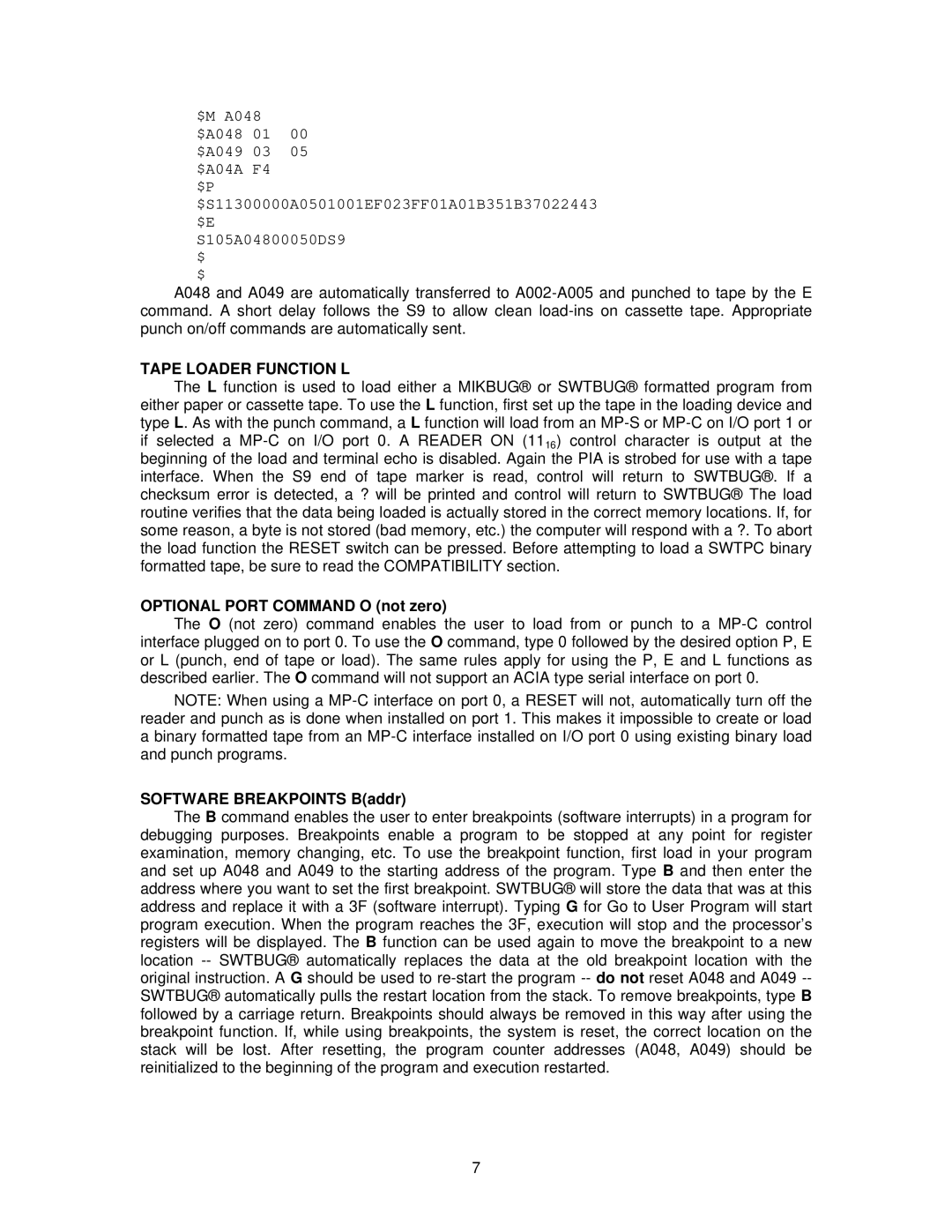$M A048 | |
$A048 | 01 | 00 |
$A049 | 03 | 05 |
$A04A F4 $P
$S11300000A0501001EF023FF01A01B351B37022443 $E
S105A04800050DS9
$
$
A048 and A049 are automatically transferred to A002-A005 and punched to tape by the E command. A short delay follows the S9 to allow clean load-ins on cassette tape. Appropriate punch on/off commands are automatically sent.
TAPE LOADER FUNCTION L
The L function is used to load either a MIKBUG® or SWTBUG® formatted program from either paper or cassette tape. To use the L function, first set up the tape in the loading device and type L. As with the punch command, a L function will load from an MP-S or MP-C on I/O port 1 or if selected a MP-C on I/O port 0. A READER ON (1116) control character is output at the beginning of the load and terminal echo is disabled. Again the PIA is strobed for use with a tape interface. When the S9 end of tape marker is read, control will return to SWTBUG®. If a checksum error is detected, a ? will be printed and control will return to SWTBUG® The load routine verifies that the data being loaded is actually stored in the correct memory locations. If, for some reason, a byte is not stored (bad memory, etc.) the computer will respond with a ?. To abort the load function the RESET switch can be pressed. Before attempting to load a SWTPC binary formatted tape, be sure to read the COMPATIBILITY section.
OPTIONAL PORT COMMAND O (not zero)
The O (not zero) command enables the user to load from or punch to a MP-C control interface plugged on to port 0. To use the O command, type 0 followed by the desired option P, E or L (punch, end of tape or load). The same rules apply for using the P, E and L functions as described earlier. The O command will not support an ACIA type serial interface on port 0.
NOTE: When using a MP-C interface on port 0, a RESET will not, automatically turn off the reader and punch as is done when installed on port 1. This makes it impossible to create or load a binary formatted tape from an MP-C interface installed on I/O port 0 using existing binary load and punch programs.
SOFTWARE BREAKPOINTS B(addr)
The B command enables the user to enter breakpoints (software interrupts) in a program for debugging purposes. Breakpoints enable a program to be stopped at any point for register examination, memory changing, etc. To use the breakpoint function, first load in your program and set up A048 and A049 to the starting address of the program. Type B and then enter the address where you want to set the first breakpoint. SWTBUG® will store the data that was at this address and replace it with a 3F (software interrupt). Typing G for Go to User Program will start program execution. When the program reaches the 3F, execution will stop and the processor’s registers will be displayed. The B function can be used again to move the breakpoint to a new location -- SWTBUG® automatically replaces the data at the old breakpoint location with the original instruction. A G should be used to re-start the program -- do not reset A048 and A049 -- SWTBUG® automatically pulls the restart location from the stack. To remove breakpoints, type B followed by a carriage return. Breakpoints should always be removed in this way after using the breakpoint function. If, while using breakpoints, the system is reset, the correct location on the stack will be lost. After resetting, the program counter addresses (A048, A049) should be reinitialized to the beginning of the program and execution restarted.
7
